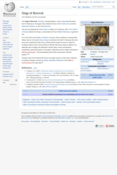The Zhemao hoaxes were over 200 interconnected Wikipedia articles about falsified aspects of medieval Russian history written from 2012 to 2022 by Zhemao (Chinese: 折毛; pinyin: Zhémáo), a pseudonymous editor of the Chinese Wikipedia. Combining research and fantasy, the articles were fictive embellishments on real entities, as Zhemao used machine translation to understand Russian-language sources and invented elaborate detail to fill gaps in the translation. It is one of Wikipedia's largest hoaxes.
Zhemao started this practice as early as 2010 on Chinese history topics but turned to Russian history, and the political interactions of medieval Slavic states in particular, in 2012. Many of her hoax articles were created to enhance her initial fabrications. Zhemao eluded detection for over a decade by faking a persona as a Russian history scholar, using sockpuppet accounts to feign support, and exploiting the community's good faith that her obscure sources matched articles' content.
Chinese novelist Yifan, having initially been intrigued by a narrative about a Kashin silver mine before finding its sources did not verify its claims, made a blog post in June 2022 explaining the web of hoax articles. Zhemao posted an apology the same month and revealed herself to have neither an advanced degree nor fluency in English or Russian. She attributed her use of sockpuppet accounts to her loneliness and absence of other social relationships. Volunteer editors blocked her accounts and quickly deleted her hoax articles though cleanup continued a month later.

